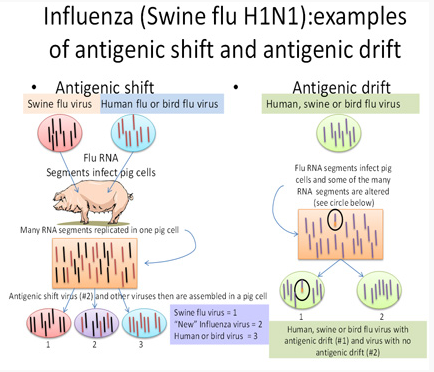What are the causes of the flu (influenza)?
Influenza virus information
Influenza viruses cause the flu and are divided into three types, designated A, B, and C. Influenza A and influenza B are responsible for epidemics of respiratory illness that occur almost every winter and are often associated with increased rates of hospitalization and death. Influenza type C differs from types A and B in some important ways. Type C infection usually causes either a very mild respiratory illness or no symptoms at all; it does not cause epidemics and does not have the severe public-health impact of influenza types A and B. Efforts to control the impact of influenza are aimed at types A and B.
Influenza viruses continually change over time, usually by mutation (change in the viral RNA). This constant changing often enables the virus to evade the immune system of the host (humans, birds, and other animals) so that the host is susceptible to changing influenza virus infections throughout life. This process works as follows: A host infected with influenza virus develops antibodies against that virus; as the virus changes, the "first" antibody no longer recognizes the "newer" virus and infection can occur because the host does not recognize the new flu virus as a problem until the infection is well under way. The first antibody developed may, in some instances, provide partial protection against infection with a new influenza virus. In 2009, almost all individuals had no antibodies that could recognize the novel H1N1 virus immediately.
Type A viruses are divided into subtypes or strains based on differences in two viral surface proteins called the hemagglutinin (H) and the neuraminidase (N). There are at least 16 known H subtypes and nine known N subtypes. These surface proteins can occur in many combinations. When spread by droplets or direct contact, the virus, if not killed by the host's immune system, replicates in the respiratory tract and damages host cells. In people who are immune compromised (for example, pregnant women, infants, cancer patients, asthma patients, people with pulmonary disease, and many others), the virus can cause viral pneumonia or stress the individual's system to make them more susceptible to bacterial infections, especially bacterial pneumonia. Both pneumonia types, viral and bacterial, can cause severe disease and sometimes death.
Antigenic shift and drift
Influenza type A viruses undergo two major kinds of changes. One is a series of mutations that occurs over time and causes a gradual evolution of the virus. This is called antigenic "drift." The other kind of change is an abrupt change in the hemagglutinin and/or the neuraminidase proteins. This is called antigenic "shift." In this case, a new subtype of the virus suddenly emerges. Type A viruses undergo both kinds of changes; influenza type B viruses change only by the more gradual process of antigenic drift and therefore do not cause pandemics.
The 2009 pandemic-causing H1N1 virus was a classic example of antigenic shift. Research showed that novel H1N1 swine flu has an RNA genome that contains five RNA strands derived from various swine flu strains, two RNA strands from bird flu (also termed avian flu) strains, and only one RNA strand from human flu strains. According to the CDC, mainly antigenic shifts over about 20 years led to the development of novel H1N1 flu virus. A diagram that illustrates both antigenic shift and drift can be found below (see Figure) and features influenza A types H1N1 and bird flu (H5N1), but almost every influenza A viral strain can go through these processes that changes the viral RNA.

This article is provide from [Metatron 4025 hunter],please indicate the source address reprinted:http://www.healthycarer.com/news/other/1519.html






